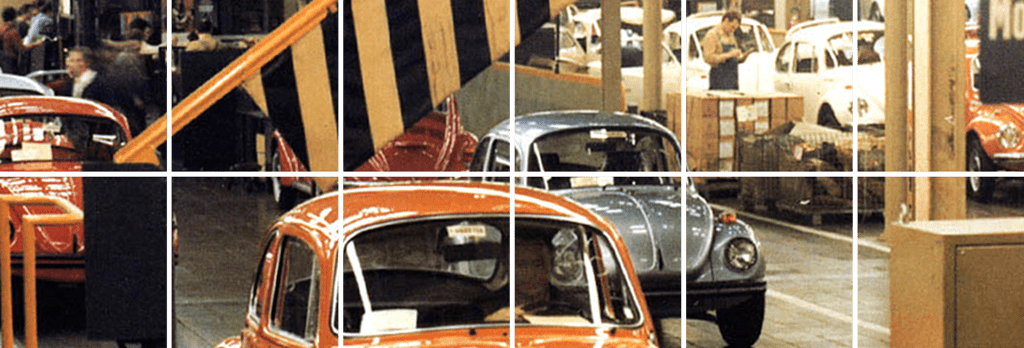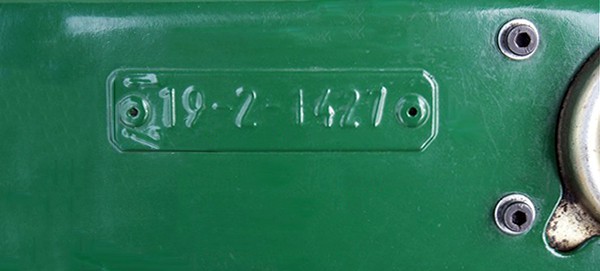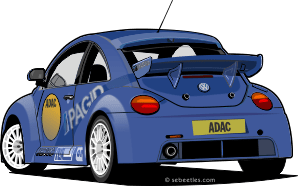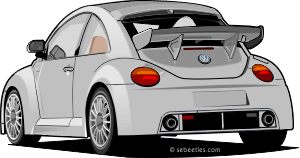
As more and more owners contact us asking for help to identify whether the Beetle they have is an SEB or not we are finding increasing numbers of former SEBs hiding under later updating and repaints – often with original light clusters, wheels and bumpers changed in line with the ebb and flow of fashions of the day.
Often the identification process is difficult when all original paperwork for the car has been lost over time. In these situations, the fact that on European manufactured Beetle saloons from the 1971 model year onwards, a production plate remains on the car is the link to the start of positive identification. With the certain knowledge of the original paintwork colour searches for other clues can begin: checking for scraps of original upholstery material, has the Beetle got distinctive fittings such as a padded dashboard, non standard “Sports” gearshift, traces of wood effect dashboard trim, black plastic beading to the wing/body joints etc.,
The finite identification of an SEB without any original paperwork falls to two things – a Stiftung AutoMuseum Volkswagen Birth Certificate and double checking the declarations on that certificate and the evidence from the Beetle itself against the information we provide on the website.
The car’s “production plate” is located on the front apron of your car, painted in body colour, adjacent to the bonnet lock.

The keys to deciphering it are as follows and then supplemented with worked examples:
- the code rotated 90 degrees clockwise at the left-hand end of the plate is the factory and brochure body colour number. These are fully explained in article P-E. Paint numbers have two forms. The main “L” (Lack Nr.) number that we use in the tables and individual SEB profile descriptions were abbreviated to a shorter code for use in sales brochures, sales documentation, production print out labels and production plates, (VW typ.15 Beetle cabriolets manufactured at the Wilhelm Karmann GmbH factory in Osnabrück are the exception in this respect. A usual practice on the Karmann production line was to handwrite the paint colour and code on a completed panel not normally visible when the vehicle was finished – see the individual profile on the 1974 North American markets Sun Bug for an illustration of this)
- Brochure paint codes can generally be found underneath the colour swatch printed in the sales brochure. These contributed the first two numbers of a six-digit coding system that combined the body paint colour, upholstery material colour and cabriolet hood colour or optional roof paint colour (Karmann Ghias and typ.3’s). The flaw in this information trail is that for many SEBs no sales brochure was produced – or if it was the paint colours were referred to by jazzed up marketing names rather than the official Lack name (see article E.5 Literature),
- Brochure paint numbers for most of the standard paint colours can be found in the excellent charts available at thesamba.com. The tables do not, however, include many of the non-standard paint colours used on SEBs that are, uniquely, listed in our paint colour tables. Our tables P-E.5 and P-E.6 available HERE list these brochure codes. Further information can be found by accessing the very helpful Glasurit website which shows the brochure paint reference number for some colours but not all.
- depending on the model year of your car (that is the August – July production year known variously as Baujahr (BJ), Build Year or Model Year rather than calendar year). The code formatting varies slightly with era – later years have the paint code on a separate plate.

- production calendar year week (ww), production day (d – Monday is day 1 to Saturday day 6), then the factory production number.
- to get the birth day of your car search the two calendars of your model year (taking into account the model year is August 1st to end July – see 1972 model explanation below) then apply your calendar year week – noting that each production week represents a FULL week – to either of those.

In the examples image above the first one is a ’72 model (produced between August 1971 and July 1972), production/brochure paint code 18 ( L51B Gentian Blue), built in the 51st week of 1971 on a Tuesday (n.b. no ’72 model 1302’s built in the 51st week of 1972).
The second is a ’74 model (produced between August 1973 and July 1974), production/brochure paint code E9 ( L16M Tunis Yellow) built in the 41st week of 1973 also on a Tuesday. See also article P-E and Worked Example 4.
A worked example of how the production/brochure six digit numbers built up a specification for a particular car is 18 31 52. This tells us that this particular Beetle is a 1302 Cabrio with 18 – – Gentian blue (L51B) paintwork. (The brochure entry shows 18 18 – – which unless modified denotes a saloon with body and roof the same colour.) – – 31 – – Light sand Cabrio hood material – – – – 52 Grey-white leatherette upholstery.
See specific information on the Brazilian Production Plates (in Portuguese).
See our complete SEBeetles Paint List tables to help you with paint and the production plate codes HERE.
View the full Guide (best viewed in full screen) –
Copyright Stephen Paul Hardy/Colin Shinkin







